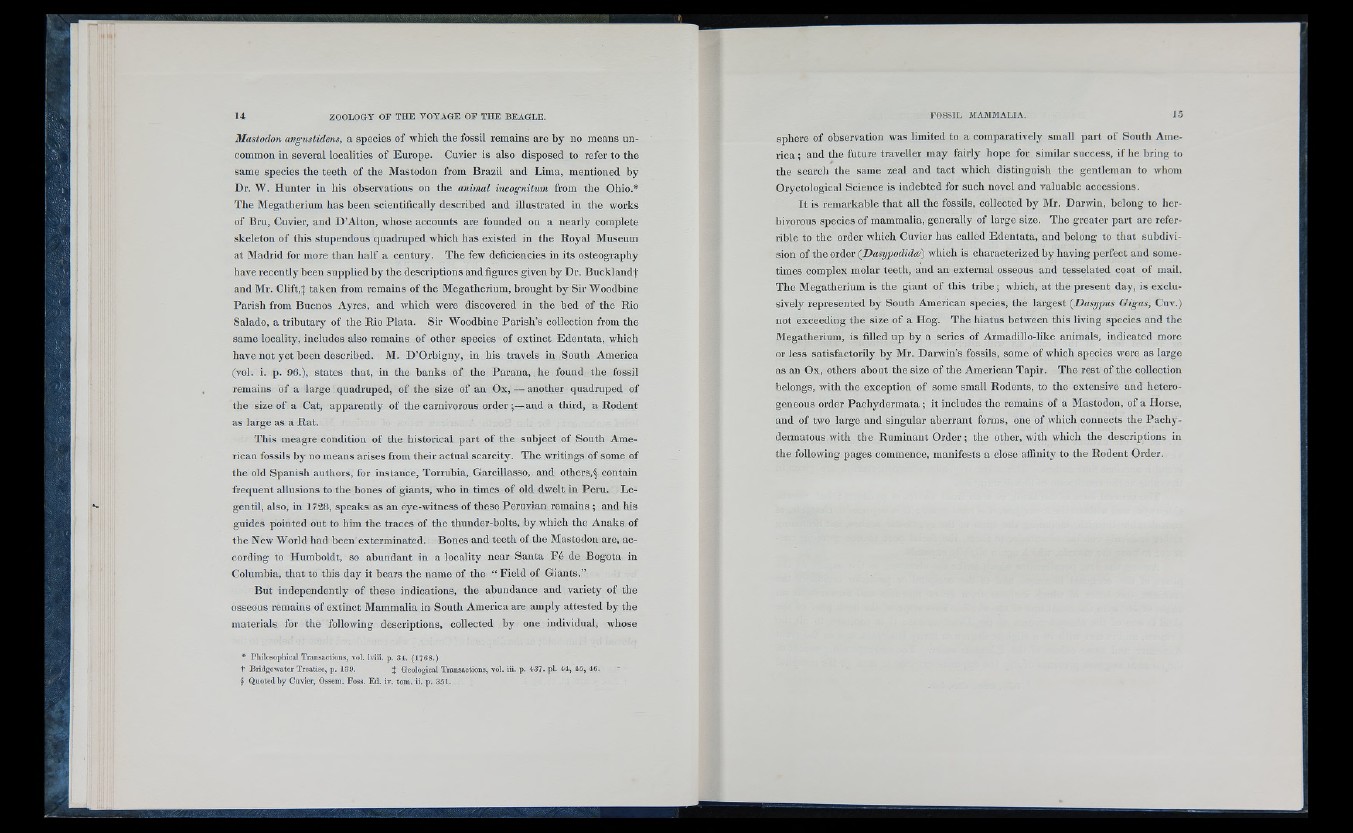
Mastodon angusiidens, a spe cie s o f which the fossil remains are by no means uncommon
in several localities o f Europe. Cuvier is also disposed to refer to the
same species the teeth o f the Mastodon from Brazil and Lima, mentioned by
Dr. W. Hunter in his observations on the animal incognitum from the Ohio.*
The Megatherium has been scientifically described and illustrated in the works
of Bru, Cuvier, and D ’Alton, whose accounts are founded on a nearly complete
skeleton o f this stupendous quadruped which has existed in the Royal Museum
at Madrid for more than h a lf a century. The few deficiencies in its osteography
have recently been supplied by the descriptions and figures given by Dr. B ucklandt
and Mr. Clift4 taken from remains o f the Megatherium, brought b y Sir Woodbine
Parish from Buenos Ayres, and which were discovered in the bed o f the Rio
Salado, a tributary o f the Rio Plata. Sir Woodbine Par ish’s collection from the
same locality, includes also remains o f other species of extinct Edentata, which
have not yet been described. M. D ’Orbigny, in his travels in South America
(vol. i. p. 96.), states that, in the banks o f the Parana, he found the fossil
remains of a large quadruped, o f the size o f an Ox, — another quadruped o f
the size o f a Cat, apparently o f the carnivorous order and a third, a Rodent
as large as a Rat.
This meagre condition o f the historical part o f the subject o f South American
fossils b y no means arises from their actual scarcity. The writings o f some of
the old Spanish authors, for instance, Torrubia, Garcillasso, and others,§ contain
frequent allusions to the bones o f giants, who in times of old dwelt in Peru. Le-
gentil, also, in 1728, speaks as an eye-witness o f these Peruvian remains ; and his
guides pointed out to him the traces o f the thunder-bolts, by which the Anaks of
the New World had been exterminated. Bones and teeth o f the Mastodon are, according
to Humboldt, so abundant in a locality near Santa F 6 de Bogota in
Columbia, that to this day it bears the name o f the “ Field o f Giants.”
But independently o f these indications, the abundance and variety o f the
osseous remains o f extinct Mammalia in South America are amply attested by the
materials for the following descriptions, collected by one individual, whose
* Philosophical Transactions, vol. Iviii. p . 34. (1768.)
t Bridgewater Treatise, p. 139. + Geological Transactions, vol. iii. p. 437. pi. 44, 45, 46.
§ Quoted by Cuvier, Ossem. Foss. Ed. iv. tom. ii. p. 351.
sphere o f observation was limited to a comparatively small part o f South America
; and the future traveller may fairly hope for similar success, if he bring to
the scarcli the same zeal and tact which distinguish the gentleman to whom
Oryctological Science is indebted for such novel and valuable accessions.
It is remarkable that all the fossils, collected by Mr. Darwin, belong to herbivorous
species o f mammalia, generally o f large size. The greater part are refer-
rible to the order which Cuvier has called Edentata, and belong to that subdivision
o f the order (Basypodidai) which is characterized by having perfect and sometimes
complex molar teeth, and an external osseous and tesselated coat o f mail.
The Megatherium is the giant o f this tr ib e ; which, at the present day, is exc lusively
represented by South American species, the largest (Dasypus G igas, Cuv.)
not exceeding the size o f a Hog. The hiatus between this living species and the
Megatherium, is filled up by a series o f Armadillo-like animals, indicated more
or le ss satisfactorily by Mr. Darwin’s fossils, some o f which species were as large
as an Ox, others about the size o f the American Tapir. The rest o f the collection
belongs, with the exception o f some small Rodents, to the extensive and heterogeneous
order Pachydermata ; it includes the remains o f a Mastodon, o f a Horse,
and o f two large and singular aberrant forms, one o f which connects the P a chy dermatous
with the Ruminant Order ; the other, with which the descriptions in
the following pages commence, manifests a close affinity to the Rodent Order.